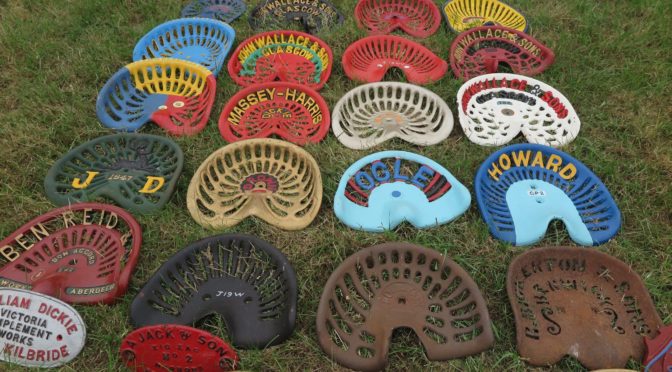What was on display at the Highland Show in 1890?
In that year the Show was held at Dundee, in the Perth Show District. This was one of the more important districts for the display of agricultural implements and machines. However, in 1890 there was an agricultural depression which was to continue into the start of the next decade. This had an impact on the farming systems used (including area under crop), the amount of money farmers had to spend, the types of new implements and machines being developed and on sale, and interest in what was being exhibited. These factors helped to shape the character of implements and machines at the Highland Show in 1890.
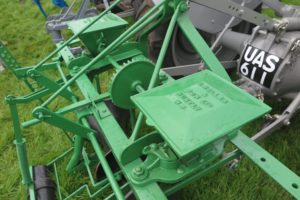
The North British Agriculture, the national Scottish agricultural newspaper provided a critique of the show. It includes reflection of the implement department as well as a description of the exhibitors and their stands:
“In such a busy commercial centre, it was only to be expected that there would be a good general display of farm implements. Not only have the local manufacturers and agents turned out in full strength, but there are many exhibitors from both north and south of the Tay; while a good few of the leading makers from the south side of the Tweed are, as usual, well represented.
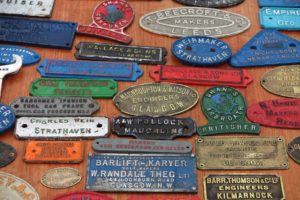
There is, however, very little of a really new or novel character on exhibition. Various kinds of the implements such as potato diggers, harvesting machinery, &c, have been improved and perfected where this was possible since last season; but, as a general rule, there is little or nothing that will strike the visitor as radically new or much in advance of anything that has been seen for the past few years. All the exhibitors, however, have striven to make their collections as comprehensive and complete as possible; and the probability is that visitors will find this important department as well stocked, and as interesting at the Dundee Show as at most of the previous meetings of the Society. The competitive trials are this year confined to grist mills, for which prizes of £15 and £10 are offered. The price of the machine is not to exceed £25, and to be limited to eight horse power, and the mill is to be able to knibble or grind all kinds of grain. There are seventeen machines entered by the following exhibitors:-Blackstone & Co., Stamford; W. N. Nicholson & Sons, Newark; Woodroffe & Co., Rugeley; Wm Balfour, Pittenweem; Barford & Perkins, Peterborough; and R. G. Morton, Errol. The judges in this competition will conduct their operations simultaneously with those in the stock departments; and it is expected that the awards will be announced in the course of the second day of the show. Appended are a few notes of the various stands picked up in the course of a hurried walk through the implement yard on Monday-
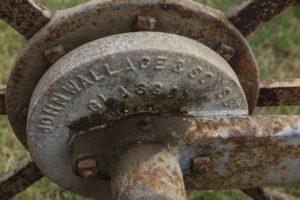
Messrs J. D. Allan & Sons, Dunkeld, occupy as usual stand no. 1 with a large selection of their well-known farm implements. Quite a new one is a turnip cutting cart for sheep, which Messrs Allan have recently introduced to meet a growing demand. It is specially suited for the requirements of those who purchased blackfaced cast ewes for fattening on the low ground. The turnips are loaded into the cart and are cut as they are distributed by a Gardener’s revolving turnip cutter fitted underneath the cart, the power being supplied from the motion of the wheels. The turnips are cut into finger pieces and distributed with regularity all over the field. The operation is performed much more easily and expeditiously than by being cut first, then loaded and shovelled out, as by the old method.
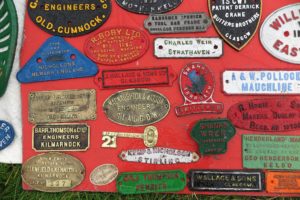
Messrs Auchinachie & Simpson, of Keith, occupy the next place with neat collection of very serviceable implements. Besides a turnip and mangold sower, ridging plough, and broadcast sower, this firm show their steel tined keyed harrows in several sizes. These harrows have from their efficiency obtained a good reputation for their strength and firmness, while it claimed for them that they will wear about twice the time of the ordinary harrow.
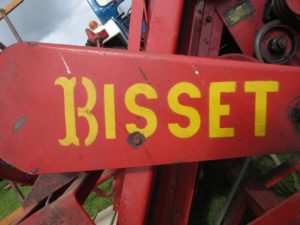
Messrs Bisset & Sons, Blairgowrie, have the largest stand in the showyard in the implement shedding, and here we find the “Speedwell” reaper, which for efficient back delivery and light working enjoys a good name, and also the “Bisset” mower, a new pattern machine which has done excellent service in the hay harvest this year, Two binders are also shown, but it is at Messrs Bisset’s other stand, in the machinery in motion section, that these now famous machines are to be seen to advantage.
Mr Thomas Hunter, of Maybole, amongst a very large selection of cultivating implements, shows the “Hunter” hoe-a remarkably serviceable little implement, which can be adapted to a great many purposes. It can be used for cleaning turnip drills previous to thinning, for ridging and grubbing potato drills, or it can be adapted to serve as an expanding drill harrow, or as a five tined drill grubber. The side frames being angle steel, are very rigid; and although the general appearance of the implement is light, it is nevertheless strong enough for the stiffest soils. Although this is one of the handiest little instruments we have seen for the requirements of green crop growers.
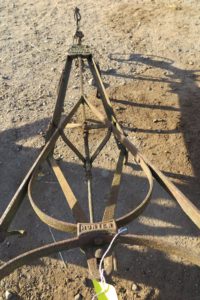
Stand No. 8 is occupied by Mr William Elder, of Tweedside Implement Works, Berwickshire on Tweed. Prominent among his exhibits is the Brantford steel binder, made by Messrs Harris, Sons & Co, of Brantford, Ont, Canada, who claim to be the largest manufacturers of self-binding harvesters in Her Majesty’s Dominions. This machine is strongly built of steel and malleable iron, and is fitted with all the most recent improvements. Mr John Clay, of Kerchesters, Kelso, is also agent for these machines, and has for several seasons cut his entire crop with them, and speaks very highly of their efficiency. This, by the way, is the binder which did such remarkable work in cutting laid crops in Northumberland last season, of which notice was taken at the time in our columns. Now that the harvest is approaching, the labour difficulty has again to be faced. Those who find difficulty in obtaining hands should make a point of inspecting this labour saving implement. Me Elder also exhibits several beautifully finished broadcast sowing machines, fitted with adjustable swivel for going through gateways. Horse rakes, turnip sowers, reapers, and mowers complete this display.
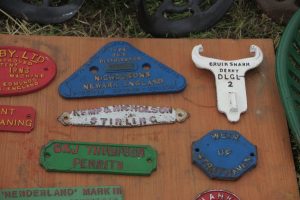
Messrs Kemp & Nicholson, the old-established implement makers, of Scottish Central Works, Stirling, show their “Stirling Castle” self-acting back-delivery reaper, their new “Waverley” reaper and mower, and also their new “North British” reaper and mower, into which steel parts have been introduced in place of iron where strength is required. Amongst their large and varied collection we select for mention their iron sheep fodder rack, which has not been shown at a Highland Show for many years, but which is an invaluable piece of apparatus for flockmasters. The chief novelty, however, on this stand is a cart turnip cutting machine, which is fitted with a revolving slicer for distributing turnips to sheep being fed on grass land. Another very prominent exhibit of this firm’s is a varnished tipping cart of superior finished, with double self-acting lock and elevator.
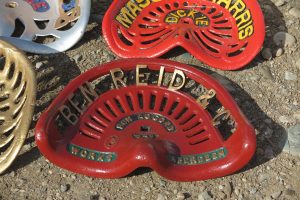
Messrs Ben Reid & Co., of Aberdeen, have their usual large and important collection. One of the first things to attract attention on this stand is their “Bon Accord” back delivery reaper and rake, which has won for itself a good name all over the north-east of Scotland. Next we observe their patent broadcast sowers, with folding apparatus, and then their patent manure distributor; but the name of “Ben Reid” attached to such implements is sufficient guarantee of their serviceableness, so that further description is needless. Grubbers, pumps, draining rods, garden seats, and hay gatherers are amongst the various specialities of this firm; but a hay baling press, of a new pattern, is a decided novelty.
Messrs Geo. Sellar & Son, Huntly, have, as usual, a very striking collection of ploughs, with long mould boards, adapted for working stiff land. They also show their Anglo-American plough, which is adapted for working on lighter land; while harrows, made of steel, and driven tines, are also a prominent part of this old established firm’s display. It is shown this year with jointed finger bar and a new in-and-out of gear arrangement, for which an additional patent has been applied for. Altogether, this is one of the most efficient and approved harvesters in the market. Chaff cutters, oilcake mills, pulpers, and other food preparing machinery compete this firm’s exhibit.
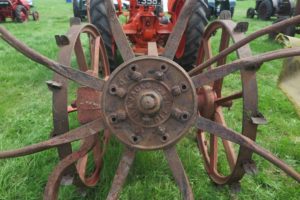
Messrs Jack & Sons, of Maybole, have a prominent stand, which are to be found specimens of their Caledonian “Buckeye” mower and reaper, which we have often described at former meetings of the Highland Society. Messrs Jack are also strong in cultivating implements as well as food-preparing machinery; while their spring carts and vans, as regards quality of material and workmanship, leave little to be desired.
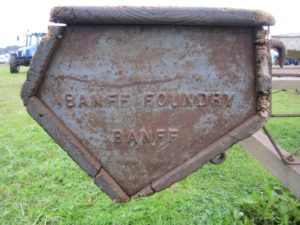
Messrs G. W. Murray & Co., Banff. This old-established Scotch implement firm was represented at stand No. 20. Amongst their numerous exhibits are to be found their “Victory” back delivery reaper, as designed by the late Mr Murray, who was the first to bring out a back delivery reaper of the light pattern; and it must be gratifying to his successors to see other makers adopting the same principle. Messrs Murray show also their hand lever shearing machine, which can cut a bar of iron an inch thick, owing to the powerful way the leavers are arranged.
Mr Robert Kyd, of Coupar Angus, shows his potato diggers and planters, which we have often fully described.
Messrs Newlands & Son, of Linlithgow, show several very useful general purpose and drill ploughs.
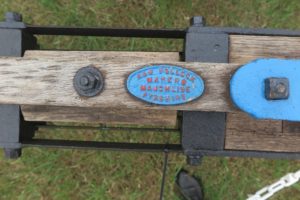
Messrs D. Paterson & Sons, Alloa, show a self-acting horse rake and set of wrought iron whipple trees.
Messrs Thomas Sherriff & Co., Dunbar, are a firm we always expect to find in full at a “Highland”. Their display this year will well sustain the credit of this firm for broadcast sowers, for which they are experiencing a very good demand. Amongst these machines, we observe their broadcast sower which took the Highland Society’s premium at Dumfries, about twenty years ago, and also their machine of more recent type, which came out victorious at the Perth trials of 1888. Their fourteen row lever corn drill, with single wheel steerage and land measuring index, is a very useful machine, so that we are not surprised to learn that Messrs Sherriff find that it has become what we may call a “general favourite”.
Mr William Ford, of Fentonbarns, Drem, shows the “Toronto” binder, which, since its introduction several seasons ago, has attained quite an unprecedented popularity amongst the class who require binders. It is the same as last season, except in one of two minor details.
Mr A. Pollock, of Mauchline, showed his improved hay and straw press and trusser, which has a very ingenious transport arrangement; also his new patent rick shifter, which is now largely used in the west of Scotland. No other of Mr Pollock’s exhibits call for special comment.
Mr John Scoular, of Stirling, shows his patent horse rake, with triple active leverage, in nine different sizes.
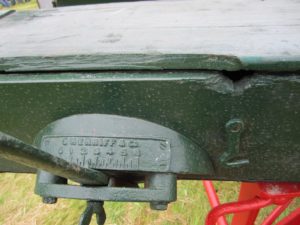
Mr Alexander Grant, Rothes, shows a steel single plough, and a steel drill plough of approved pattern.
Mr Wm. Davidson, Mintlaw, is again forward at the “Highland” after a few years’ absence. His artificial manure distributor, and natural manure distributor, are first class machines of their kind, and a large number of visitors to the show were highly pleased with an inspection of these machines.
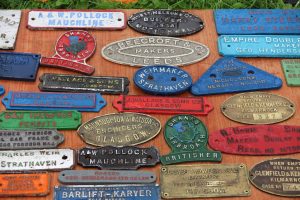
Mr John Doe, of Errol, who acts as an agent for a great number of important implement makers, has a large stand replete with farm implements of all descriptions.
Messrs Flear & Thomson, of Dunfermline, show Wardlaw’s patent turnip thinner, which is the only implement of this description made on the hortizontal principle, and which, we believe, has done excellent work. In a damp season like the present, when the young plants grow so rapidly, a machine like this is a vey valuable acquisition on any farm where there is a large acreage of turnips. On this stand there is also shown a potato dresser, made by Mr Molleson, of Balwearie, Kirkcaldy, which separates the tubers in various sizes by means of a revolving screen with graduated apertures.
Messrs John Wallace & Sons, Graham Square, Glasgow, exhibit at stand 31 a large and interesting collection of reaper and mowers, food preparing machinery, horse rakes, cultivators, &c. Prominent amongst their harvesting implements are their well-known the “City of Glasgow” and “Thistle” reapers, both of which have acquired a wide reputation, and have been largely used for several seasons in both England and Scotland. There also exhibit a combination mower and reaper which is so constructed that it can be either used for back or manual delivery. The famous “Oliver” chilled plough is also seen to great advantage on this stand, the firm having the sole agency in Britain for the sale of this valuable implement.
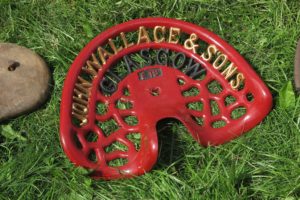
Messrs John Turnbull & Son, Carnock, Larbert, exhibit at the adjoining stand (30) two specimens of the portable hay or straw trusser with which they won the Society’s prize at the Melrose Show last year. This is a most useful implement on all farms, and it is not only light and simple in working, but exceedingly cheap.
Mr David Williamson, Carron Bridge, Thornhill, has brought all the way from Dumfriesshire, and exhibits at stand 32, several samples of his manufactures, such as farm carts, gardeners’ barrows, navvy’s barrow, and a Laide barrow. These useful articles appear to be substantially made, and are admirably finished.
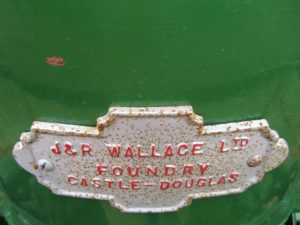
Messrs Alex Wood & sons, Stockwell Street, Glasgow, make a speciality of farm and other weighing machines, several samples of which they exhibit at stand 53. These machines are made in great variety, and are fitted with all the latest improvements. This firm have recently invented and patented a process which completely removes the difficulty that has often been experienced in registering the exact weight of an article, owing to the vibration of the needle of the dial. By a simple process, the needle is made fast the moment the full weight is attained.
How many makers and their implements do you recognise?
